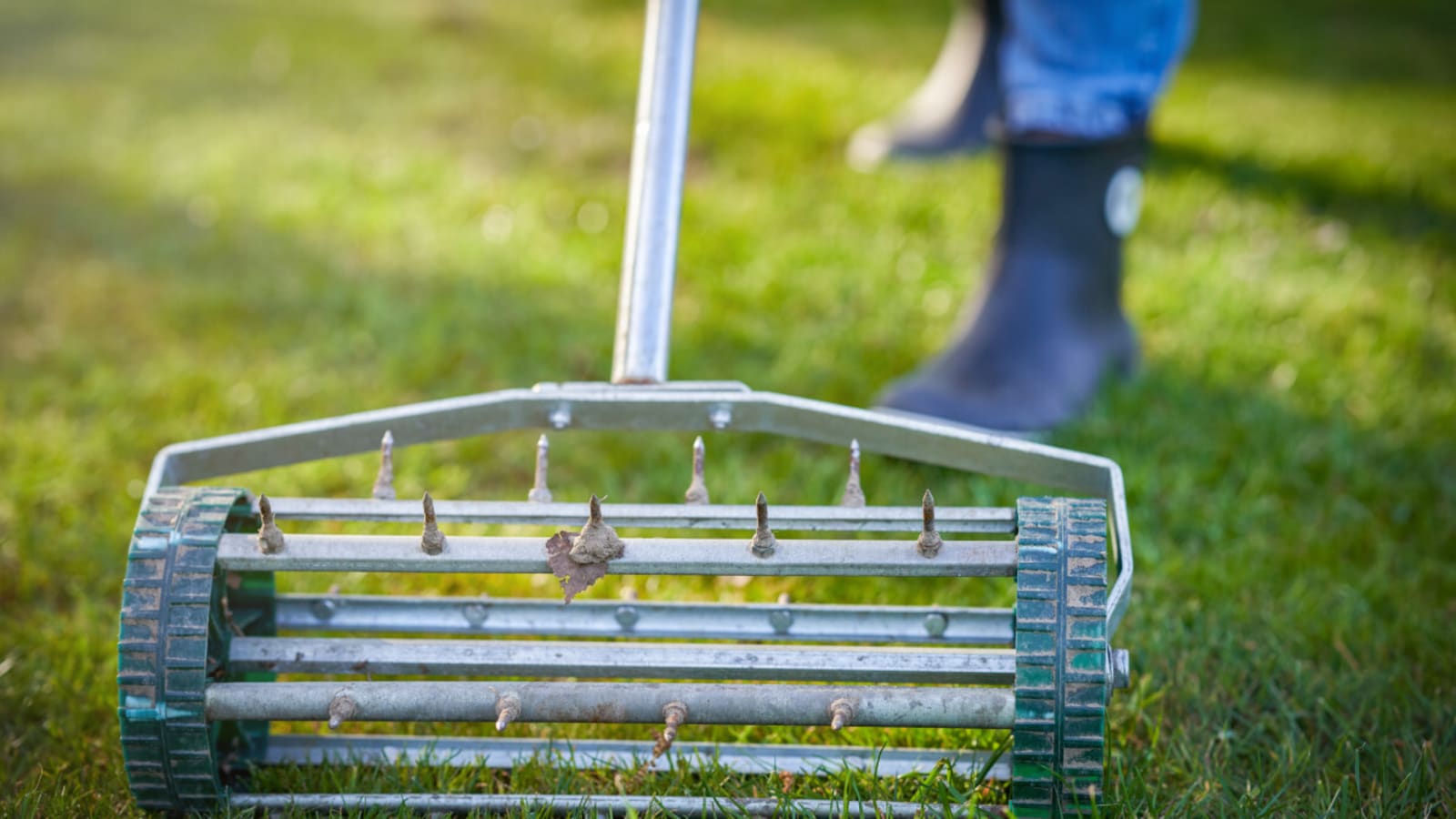
A healthy lawn needs more than regular mowing and watering. Over time, the soil beneath your grass can become compacted, making it harder for roots to get the oxygen and nutrients they need. That’s where lawn aeration comes in. Truthfully, there are lots of different aerators on the market, and ones like the above rolling product are one solution, but we've found core aerators to be most effective.
By removing small plugs of soil, aeration loosens the ground and promotes optimal growth by creating space for air, allowing better nutrient absorption, and more intake of water. But how often do you really need to aerate? The frequency of aeration varies depending on your soil type, grass use, and climate.
What Happens When I Aerate?
A core aerator is a machine with hollow metal tubes on a rotating drum that poke into the ground a few inches deep and pull out plugs. The cores that come out are typically 2- to 3-inch soil plugs long and about a half inch in diameter. Their size depends on factors like soil type, soil compaction, moisture levels, and the type of aerator used, usually the best results come from a gas-powered, push-behind core aerator.
How Often Should You Aerate?
Most yards benefit from lawn aeration once a year, but some need it more often depending on type of soil and grass type.
Frequency of aeration depends on multiple factors, yards with heavy foot traffic, heavy clay soil, soil compaction, or a layer of thatch buildup may need core aeration twice a year—once in spring and again in fall. If you have sandy soil or your soil is looser or your yard sees little use, aerating every other year might be enough. Timing and type of grass also matters. Cool-season grasses, like fescue and bluegrass, do best when aerated in late summer or early fall, while warm-season grasses, like Bermuda and zoysia, respond better to late spring aeration.
Signs your lawn needs aeration:
- Poor drainage, water pools on the surface instead of soaking in
- Grass looks thin or grass growth struggles
- Soil feels rock solid when you press a screwdriver into it
- Excessive thatch (more than half an inch of thatch)
What Happens If You Aerate Too Much?
Frequent aeration can have negative effects on your grass health rather than help it.
Aeration is great, but doing it too often can weaken your grass and stunt root growth. When soil is repeatedly disturbed, grass roots can struggle to re-establish, making your lawn more prone to weeds and drought stress. If you aerate with a core aerator more than twice a year, you might be doing more harm than good.
The best time for aeration is when the lawn shows signs of soil compaction, rather than sticking to a strict aeration schedule.
Can You Aerate Without a Machine?
Yes, but manual methods take more time and effort, especially on larger lawns.
A core aerator, which has hollow tines that remove plugs of soil, is the most effective tool. If you don’t have one, you can rent one or hire a lawn care service. Manual aerators, like solid-tine or spiking devices, or handheld tools can help but won’t loosen the soil as well as an aeration machine. Some homeowners use aerator shoes (spiked shoes), but these can actually make the level of compaction worse by pressing the soil down instead of pulling it up.
Best Practices for Aerating Your Lawn
A few simple steps can make aeration more effective.
Aerating at the right time and in the right way will give you the best results. Here are some tips to get the most out of the process:
- Water your yard a day or two before aerating. Moist soil is easier to penetrate than dry soil, so you’ll get better results.
- Use a core aerator instead of spike aerators. Core/Plug aerators remove plugs of soil, while spike aerators can actually make compaction worse.
- Aerate in multiple directions. Going over your yard twice—once in one direction, then again at a slight angle—will help loosen the soil more evenly.
- Leave the soil plugs on the turf. The soil cores break down over time and return essential nutrients to the soil.
- Overseed and fertilize after aeration. This helps grass grow thicker and healthier by taking advantage of the improved soil conditions.
How Aeration Helps with Lawn Diseases
Compacted soil can create the perfect environment for disease.
Lawn diseases thrive in areas where air circulation is poor, moisture lingers, and roots struggle. When soil is too dense, water sits on the surface instead of draining properly, increasing the risk of fungal infections like brown patch or dollar spot. Effective aeration helps by improving airflow and drainage, making it harder for these diseases to take hold. If your turf has been struggling with repeated fungal issues, regular aeration could be part of the solution.
Does Aeration Help with Weed Control?
Healthier grass can outcompete weeds more effectively.
Aeration itself won’t kill weeds, but it makes your lawn healthier, which helps reduce weed growth. When soil is compacted, grass struggles to spread, leaving open patches where weeds can take over. Aeration encourages deep roots and thicker, healthy grass, giving weed seeds less space to grow. If you follow aeration with overseeding and fertilization, you’ll strengthen your lawn’s ability to crowd out unwanted plants.
FAQ
Can I mow my lawn right after aerating?
It’s best to wait a few days. Aeration leaves holes in the soil, and mowing too soon can cause lawn compaction again. Give the turf recovery time before you mow.
Is aeration different from dethatching?
Yes. Aeration removes small plugs of soil to reduce compaction, while dethatching removes the layer of dead grass (the thatch layer) and debris on top of the lawn soil. Both help your turf, but they address different issues.
Are there businesses I can call to help?
Yes! Most lawn care professionals offer lawn aeration services. They can also suggest regular maintenance to keep healthy soil and healthier lawns.
More must-reads:
- ACC race becomes more wide open after Virginia's upset of Florida State
- Yankees cast doubt on the reigning Rookie of the Year's role in the postseason
- The 'Multiple 10-sack NFL seasons' quiz
Breaking News
Trending News
Customize Your Newsletter
 +
+
Get the latest news and rumors, customized to your favorite sports and teams. Emailed daily. Always free!








